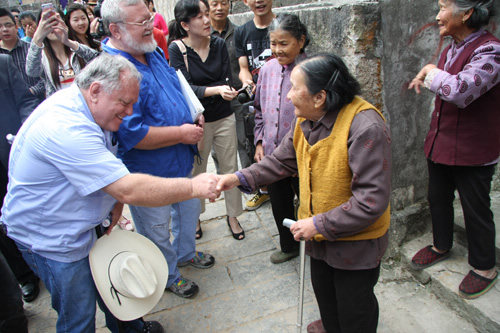|
 |
|
HAPPY GREETINGS: American-born Gary Gardner meets a local villager on his family's second roots-finding trip in southeast China's Fujian Province on September 26 (ZHOU XINJIAN) |
For the American-born Gardner brothers, Fuzhou, capital of southeast China's Fujian Province, is the same city as it was 25 years ago when they first visited—warm and welcoming.
Gary, 64, is a pastor living in Colorado, and Lee, 62, works at a nursing home in California. Their family bond with the Chinese city can be traced back to the late 19th century when their missionary ancestors first came to the country.
During the family's mission to rediscover their roots in the autumn of 1987, the Gardners traced the footprints of their ancestors across many different places. Lee carried a jar on the journey, which he filled with soil taken from outside the Fujian Medical University Union Hospital where his father and grandfather were born.
"I kept the jar on a shelf at home because it reminds me of my family roots," Lee told Beijing Review.
In addition to the hospital, the Kuling Summer Resort where their ancestors avoided the summer heat was also listed on the itinerary.
On September 27, the Kuling Post Office, which was established in 1902 and is one of the country's oldest summer post offices, resumed its function as part of the Kuling Summer Resort renovation project. The Gardners sent out postcards with a Kuliang postmark (Kuling in Fuzhou's dialect) on them to reconnect their family in the United States and the city in China.
Located some 12 km on the eastern outskirts of Fuzhou, Kuling, 800 meters above the sea level, is a mountainous area covering 24 square km. Its moderate climate makes it an ideal summer resort destination.
The remote area became popular in the late 19th century partly because Fuzhou was one of the five Chinese cities forced into foreign trade after the First Opium War (1840-42). An American missionary named S. F. Woodin discovered Kuling and rented local houses for summer recreation in 1886.
Word spread quickly among local expats. A year later, Thomas Rennie (1865-1938), a doctor at the British Consulate, built the first Western-style villa. Foreigners and wealthy locals built more villas in the following years. A summer resort complex formed during its heyday in the mid-1930s.
Milton Gardner (1901-86), Gary and Lee's great-granduncle, was a regular resident in Kuling during the summertime before returning to the United States in 1911. He was a professor of physics in the University of California, and retired at the age of 68. Revisiting Kuling became his biggest dream in his late years, but unfortunately he suffered from paralysis for years after 1972. His widow Elizabeth was familiar with the name Kuling but had no idea of its exact location.
After Milton died, a Chinese student named Zhong Han home-stayed at the Gardner's and told Elizabeth that the Chinese characters on the postmark that Milton kept was "Kuling, Fuzhou." An article he wrote about Elizabeth's story was published in the Beijing-based People's Daily.
The article entitled Ah, Kuling! was published on April 8, 1992. Xi Jinping, Chinese Vice President who then served as secretary of the Communist Party of China of the Fuzhou Municipal Committee, read the article and invited the then 76-year-old Elizabeth Gardner to visit her husband's childhood home.
In fact, the summer resort was abandoned after World War II (1939-45). The area did not reopen to the public until May 1, 1980.
| 